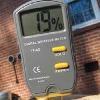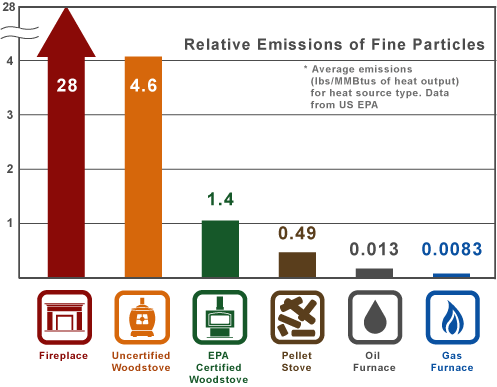 Minnesotans burn wood at home for many reasons—heating,
cooking, and recreation. Even though wood is "natural," we need to be careful about burning wood. Wood
smoke is unhealthy, even at low levels. Wood smoke contains an
abundance of chemicals, many of which are toxic and also found in
tobacco smoke. Exposures to these chemicals can lead to both short and long term health effects. Protect everyone's health by following these
recommendations.
Minimize your exposure to smoke.
Remember that burning wood can impact the health of your family and
others around you. Smoke from wood fires in the city
can reach many people. Exposure to wood smoke is especially harmful to
family members or neighbors with respiratory problems, such as asthma, or
cardiovascular disease. Always consider the number of people exposed
and the direction of the wind. Even the air quality inside your home may be affected.
Never
burn wood during air pollution health alerts. Sign up to receive Air Pollution Health Alerts in text or email from the Minnesota Pollution Control Agency.
Start each heating season by cleaning and inspecting indoor wood-burning appliances and chimneys. Look for air leakage, check for proper drafting, and remove the buildup of creosote. Creosote causes more
smoke to enter your home and can catch fire.
|

Burn
only dry, seasoned wood. Dry wood—whether in a campfire or wood
stove—releases far less smoke than fresh or wet wood. Buy a moisture
meter and check the moisture content in your wood before using it. Only
burn when moisture is 20% or less. Purchase dry wood, or learn how to
properly prepare your own dry wood. Watch the video below for more information. Download free woodshed plans (PDF) for storing dry wood.
|

Never burn
other materials. Anything other than dry fire wood—green wood,
construction waste, paper, plastic, garbage, or yard waste—will create even more
smoke and is often very toxic.
Learn about your options before heating with wood. Consider
things like your location (city or rural), access to fuel choices,
cost, and environmental and health impacts. Natural gas is a cleaner
fuel choice than wood in terms of the emissions of fine particles and
many other air pollutants, such as carbon monoxide, formaldehyde,
polycyclic aromatic hydrocarbons, and benzene. Though new EPA-certified
wood stoves are cleaner than uncertified stoves or fireplaces, they
still produce 100 times more harmful fine particle pollution
than a gas furnace for the same amount of heat.

Learn
about your local laws. Many cities have adopted ordinances
to restrict
backyard recreational fires. If wood smoke is seen by
your city to be a broad or ongoing problem, the city may be interested
in adopting an ordinance that specifically addresses wood burning. Some
cities in Minnesota have adopted ordinances addressing outdoor wood
boilers. For examples and resources, visit the MPCA wood smoke webpage.
Spread
the word. Many people are unaware of the health effects of wood smoke.
If you feel frustrated by exposure to wood smoke from someone in your
area, give your neighbor a chance to be a good neighbor. Your neighbor may not be aware they are affecting your property or
your health. Give them a copy of one of the following resources:
Explore electric vehicles (EVs) by visiting with real EV owners at National Plug in Day. You'll be able to talk with EV owners who drive their cars every day, learn about charging options, and connections to renewable energy. There will be a dozen or more EV owners who will bring their vehicles to the event and share their experiences, September 23, 1-4 p.m., South lot of Como Pavilion by the charging stations and solar PV canopy (St. Paul).
The
self-guided, public Minnesota Solar Tour features 50+ exemplary homes,
businesses, and institutions that have incorporated renewable energy
into the design and operation of their buildings, October 6, 10 a.m.-4 p.m. (statewide).
Thank you for reading
Living Green 365. This newsletter is a publication of the Minnesota Pollution
Control Agency. Please send questions or comments about living green to the
address below.
Sincerely,
Britt Gangeness and the Living Green Team
|